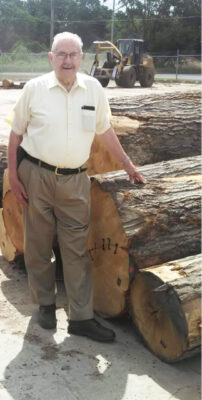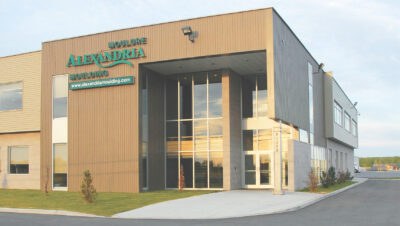Ontario Business Trends – February 2025
According to published statistics, lumber production was down both in Canada and the U.S. at year end 2024. Some secondary manufacturers and sawmills had reported a drop in orders and extended plant shutdowns over the Christmas and New Year’s Day holidays. Log supplies were declining for sawmills as temperatures had not dropped enough yet to firm ground conditions in the forests.
Exporters rushed to send Ash shipments to China and other Southeast Asian countries before the traditional New Year’s celebrations in those countries. For Canadian producers, it was reported in December there was less competition from Appalachian sales operations. However, reduced production of this species had supplies in balance with demand and prices remained mostly the same.
Demand for Basswood continues to be poor, with secondary manufacturers limiting their use of hardwood lumber for interior furnishings and fixtures. Basswood, commented contacts, is also replaced with non-wood products and engineered wood by secondary manufacturers, as are most other hardwoods. As such, sawmills reduced their green lumber production. These cutbacks settled prices for kiln-dried Basswood, pushing prices down.
Supply is meeting Birch demand, however, inventories are not excessive, noted contacts. They added supplies of Aspen are ample, but not excessive. Business is mostly with established customers, and there is little price changes in activity.
Hard Maple is one of the best-selling species in the hardwood marketplace. Business for Hard Maple and most other species, comment contacts, is based on the thickness, grade, color, and dryness. The No. 1 Common and Better and No. 1 and 2 White and good color Unselected stocks are in highest demand. Lower grades of No. 1 and 2 White and Unselected are slow to sell. Grades of off color and brown are difficult to sell, due to little interest in these at this time. Kiln-dried Hard Maple supplies were reported as ample.
The upper grades of Soft Maple, especially Sap and Better, are in highest demand. The lower grades and brown color items are not doing well. Transactions reported for green Soft Maple are in line with published figures. Kiln-dried activity remains the same.
Red Oak, an appearance species, strength of demand depends on the grade, thickness, and dryness, although the No. 1 Common and Better Red Oak are the better selling items. Some contacts state the lower grades of Red Oak are difficult to move.
White Oak has been in demand all year, with the No.1 Common and Better White Oak being the top selling items for North American hardwoods. Here also, the markets are seeking preferred grades, with different needs to fill inventory for green lumber markets. Contacts added that FAS and Select are in high demand, followed by the No. 1 Common grade. The flooring sectors are not demanding as much green No. 2A and No. 3A. Kiln-dried FAS is still seen as a top seller.
The Government of Canada tabled its Fall Economic Statement (FES) on December 16. The federal government projected a deficit of $48.3 billion in fiscal year 2024-25, $9.5 billion steeper than reported in Budget 2024, $42.2 billion in 2025-26 and in 2026-27 the government plans to bring the deficit one percent of nominal GDP. By fiscal 2029-30, the budget deficit is expected to shrink to $23 billion. Still, the government’s fiscal anchor, the debt-to-GDP ratio, remains closely aligned with Budget 2024 estimates, owing to a stronger economic forecast for nominal GDP.
New spending will total around $22.4 billion more over the next six fiscal years, with money allotted to the GST tax break, re-implementing the accelerated investment tax credit, and more spending on securing our borders. A welcome incentive to business aimed at improving productivity and investment is the Accelerated Investment Incentive at $17.4 billion. The credit allows for specific investments to be expensed immediately, applying to capital investments made between the start of 2025 and the end of 2030 and includes a 3-year phase out. It also included the two-month GST holiday (from mid-December 2024 to mid-February 2025) at $1.6 billion.
Uncertainty surrounding U.S. policy, and recent cuts to immigration targets, however, are casting doubt on short-term projections.
In response to U.S. president-elect’s 25 percent tariff threats on Canadian goods, new spending on border security was announced. The federal government is considering an export tax to discourage Trump from moving forward with the proposed tariff on Canadian goods. These measures by both the U.S. and Canada would have negative implications for both countries’ economies. These threats have the potential to upend the entire Canadian economy.
According to published statistics, lumber production was down both in Canada and the U.S. at year end 2024. Some secondary manufacturers and sawmills had reported a drop in orders and extended plant shutdowns over the Christmas and New Year’s Day holidays. Log supplies were declining for sawmills as temperatures had not dropped enough yet to firm ground conditions in the forests.
Exporters rushed to send Ash shipments to China and other Southeast Asian countries before the traditional New Year’s celebrations in those countries. For Canadian producers, it was reported in December there was less competition from Appalachian sales operations. However, reduced production of this species had supplies in balance with demand and prices remained mostly the same.
Demand for Basswood continues to be poor, with secondary manufacturers limiting their use of hardwood lumber for interior furnishings and fixtures. Basswood, commented contacts, is also replaced with non-wood products and engineered wood by secondary manufacturers, as are most other hardwoods. As such, sawmills reduced their green lumber production. These cutbacks settled prices for kiln-dried Basswood, pushing prices down.
Supply is meeting Birch demand, however, inventories are not excessive, noted contacts. They added supplies of Aspen are ample, but not excessive. Business is mostly with established customers, and there is little price changes in activity.
Hard Maple is one of the best-selling species in the hardwood marketplace. Business for Hard Maple and most other species, comment contacts, is based on the thickness, grade, color, and dryness. The No. 1 Common and Better and No. 1 and 2 White and good color Unselected stocks are in highest demand. Lower grades of No. 1 and 2 White and Unselected are slow to sell. Grades of off color and brown are difficult to sell, due to little interest in these at this time. Kiln-dried Hard Maple supplies were reported as ample.
The upper grades of Soft Maple, especially Sap and Better, are in highest demand. The lower grades and brown color items are not doing well. Transactions reported for green Soft Maple are in line with published figures. Kiln-dried activity remains the same.
Red Oak, an appearance species, strength of demand depends on the grade, thickness, and dryness, although the No. 1 Common and Better Red Oak are the better selling items. Some contacts state the lower grades of Red Oak are difficult to move.
White Oak has been in demand all year, with the No.1 Common and Better White Oak being the top selling items for North American hardwoods. Here also, the markets are seeking preferred grades, with different needs to fill inventory for green lumber markets. Contacts added that FAS and Select are in high demand, followed by the No. 1 Common grade. The flooring sectors are not demanding as much green No. 2A and No. 3A. Kiln-dried FAS is still seen as a top seller.
The Government of Canada tabled its Fall Economic Statement (FES) on December 16. The federal government projected a deficit of $48.3 billion in fiscal year 2024-25, $9.5 billion steeper than reported in Budget 2024, $42.2 billion in 2025-26 and in 2026-27 the government plans to bring the deficit one percent of nominal GDP. By fiscal 2029-30, the budget deficit is expected to shrink to $23 billion. Still, the government’s fiscal anchor, the debt-to-GDP ratio, remains closely aligned with Budget 2024 estimates, owing to a stronger economic forecast for nominal GDP.
New spending will total around $22.4 billion more over the next six fiscal years, with money allotted to the GST tax break, re-implementing the accelerated investment tax credit, and more spending on securing our borders. A welcome incentive to business aimed at improving productivity and investment is the Accelerated Investment Incentive at $17.4 billion. The credit allows for specific investments to be expensed immediately, applying to capital investments made between the start of 2025 and the end of 2030 and includes a 3-year phase out. It also included the two-month GST holiday (from mid-December 2024 to mid-February 2025) at $1.6 billion.
Uncertainty surrounding U.S. policy, and recent cuts to immigration targets, however, are casting doubt on short-term projections.
In response to U.S. president-elect’s 25 percent tariff threats on Canadian goods, new spending on border security was announced. The federal government is considering an export tax to discourage Trump from moving forward with the proposed tariff on Canadian goods. These measures by both the U.S. and Canada would have negative implications for both countries’ economies. These threats have the potential to upend the entire Canadian economy.







